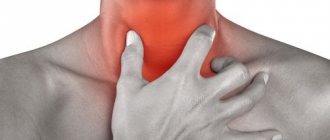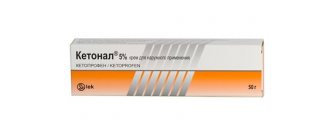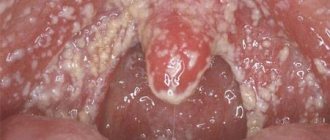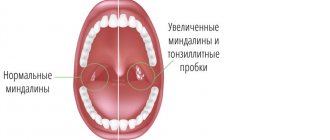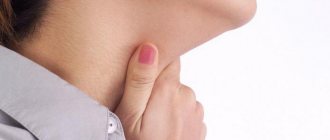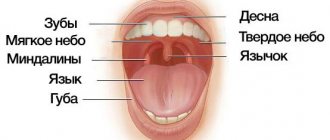People often experience a lump in the throat. Everyone has experienced this feeling at least once in their life. The feeling of a lump in the throat most often occurs without physical reasons, after experiencing stress. At some point, you notice that something is bothering your throat or starting to feel sore.
For some people, this feeling remains for a long time and even begins to cause discomfort when swallowing. In this case, other accompanying symptoms may occur, for example, sleep disturbances, increased levels of anxiety, decreased mood, etc. But there is no need to rush to conclusions and think about the presence of some complex, incurable disease or physical damage.
In the vast majority of cases, this feeling has psychological roots, and treating a lump in the throat is not difficult and responds well to therapy. However, in advanced cases, when it is not treated correctly or the process is prolonged or untreated for a long time, complications develop. Therefore, in order to undergo high-quality therapy and get rid of a lump in the throat, it is necessary to undergo a psychological differential diagnosis.
We carry out full differential diagnosis and treatment, which is completely successful in more than 90% of cases. There are many different options for disruption of higher nervous activity and the formation of sensations of a lump in the throat.
Our slogan is from quality diagnosis to complete recovery!
Find out what may be causing that lump in your throat! When is a complex disorder likely to occur? What to do when you feel a lump in your throat?
What is pharyngitis?
This is an inflammation of the mucous membrane of the pharynx and its lymphoid tissue. With pharyngitis, the throat is sore, sore and irritated. The pain intensifies when swallowing. Pharyngitis usually develops with influenza and ARVI. Viral pharyngitis usually goes away on its own. Some other less common forms of pharyngitis may require treatment.
IMPORTANT! Information from the article cannot be used for self-diagnosis and self-medication! Only a doctor can prescribe the necessary examinations, establish a diagnosis and draw up a treatment plan during a consultation!
Local therapy for pharyngitis
According to the etiological factor, acute pharyngitis can be divided into viral, bacterial, fungal, allergic, traumatic (as a result of a foreign body or surgical intervention) and caused by exposure to irritating factors (hot liquid or steam, acids, alkalis, radiation, etc.). Chronic pharyngitis is usually classified not according to etiology, but according to the nature of the changes developing in the mucous membrane: catarrhal (simple), atrophic (subatrophic) and hypertrophic. The most common form of acute inflammation of the pharyngeal mucosa is catarrhal pharyngitis during ARVI. It is known that approximately 70% of pharyngitis is caused by viruses, including rhinoviruses, coronaviruses, respiratory syncytial virus, adenovirus, influenza and parainfluenza viruses. The most common causative agent of acute pharyngitis is rhinoviruses. Research in recent years shows that their importance is growing rapidly, and now rhinoviruses are responsible for more than 80% of acute respiratory viral infections during autumn epidemics. Viral infection is often only the first phase of the disease, and it “paves the way” for subsequent bacterial infection. Chronic pharyngitis is a polyetiological disease, in the genesis of which numerous factors play a role, but the cause of exacerbation of the inflammatory process in the pharynx is most often the influence of microorganisms [3,6,9]. The conclusion is substantiated that infection plays a major role not in the occurrence, but in the chronicity of pharyngitis [1]. The main causative agents of chronic pharyngitis are: Streptococcus α–haemolyticus (107–109 CFU), β–haemolyticus (104–108 CFU), γ–haemolyticus (108–109 CFU); Staphylococcus aureus (105–108); CNS Staphylococcus (106–108); Neisseria spp. (105–107); Haemophilus spp. (103–105); Corynebacterium spp. (104–105); fungi of the genus Candida (105–108); filamentous fungi (up to continuous growth) [3]. Irrational antibiotic therapy leads to persistent dysbiotic changes in the mucous membrane of the oropharynx, immunosuppression and antibiotic resistance. When examining patients with a long and persistent history of the disease, the fungal nature of inflammation is detected in 44.7% of patients. In 90% of cases, the bacterial flora of the posterior pharyngeal wall is represented by associations of 2-3 types of microbes. At the same time, studies by a number of authors have established that the normal microflora of the oral cavity and pharynx in healthy individuals is characterized by a certain constancy. It has been established that the primary penetration of bacteria into the oral cavity occurs during the passage of the fetus through the birth canal; the initial microflora is represented by lactobacilli, enterobacteria, corynebacteria, staphylococci and micrococci, but after 2–7 days it is almost completely replaced by bacteria living in the oral cavity of the mother and maternity ward staff [10]. However, it should be taken into account that the polymorphism of bacterial contamination of the mucous membrane does not provide grounds to associate the occurrence and course of this disease with any one type of microbe. It should also be noted that the bacterial flora is represented exclusively by opportunistic bacteria that are capable of exhibiting virulence only under conditions of reduced general or local resistance of the body. This makes it possible to think that in the pathogenesis of pharyngitis, the microbial flora does not play the role of a leading and determining factor, but a violation of the protective mechanisms of the mucous membrane is of paramount importance [2]. There is evidence in the literature that in older people there is a natural change in the species composition of the microbial flora of the oropharynx. At the same time, the representation of microorganisms such as Staphylococcus aureus and aerobic gram-negative enterobacteria increases. But the reason for these changes is still not entirely clear [13]. Chronic pharyngitis is often a consequence of acute pharyngitis. Risk factors for the development of chronic pharyngitis and a possible cause of the disease may be foci of chronic infection in the pharynx, oral cavity, nose, and paranasal sinuses [14]. Despite the obvious significance of infection, there are many reasons to believe that the body’s defenses play a major role in the genesis of pharyngitis. This conclusion was made based on the ineffectiveness (in many cases) of antibiotic therapy [18]. The first line of defense for the mucous membranes is the innate immune system. It is represented by many soluble factors (molecules) found in saliva and other secretions that protect mucous membranes, as well as certain types of leukocytes. Both soluble factors and innate immune cells recognize characteristic microbial substrates: lipopolysaccharides (LPS) of gram-negative bacteria, peptidoglycan and lipoteichoic acids of gram-positive microbes, mannose, bacterial DNA, N-formylmethionine, double-stranded RNA of viruses, glycans of fungal cell walls, and much more. [12]. The innate immune system comes into play immediately, but its capabilities are limited: it can recognize only about 1000 structures [17]. The innate immune system includes cellular and humoral factors. Humoral factors of innate immunity are present in mucus, saliva, secretions, blood plasma and tissue fluid, and many directly recognize and bind pathogen antigens. This group includes, among others, bactericidal factors, lysozyme and defensins, which cause lysis of microbes [5]. The clinical picture of acute pharyngitis is characterized by soreness, dryness, discomfort and pain in the throat when swallowing (especially with an empty throat), less often - general malaise, and a rise in temperature. When the tubar ridges become inflamed, the pain usually radiates to the ears. On palpation, there may be pain and enlargement of the upper cervical lymph nodes. Pharyngoscopy reveals hyperemia of the posterior wall of the pharynx and palatine arches, individual inflamed lymphoid granules, but there are no signs of inflammation of the tonsils characteristic of angina. The clinical picture of chronic pharyngitis is not characterized by an increase in temperature and a significant deterioration in general condition. The sensations are characterized by patients as dryness, soreness and a feeling of a lump in the throat, which causes a desire to cough. The cough is usually persistent, dry and easily distinguishable from the cough that accompanies the course of tracheobronchitis. Discomfort in the throat is often associated with the forced need to constantly swallow mucus in the back of the throat, which makes patients irritable, interferes with their normal activities and disrupts sleep. Consideration of issues of therapeutic measures for chronic pharyngitis should be determined by the main pathogenetic mechanisms of the disease. First of all, it is recommended to eliminate those pathological conditions that were the cause of chronic inflammation of the pharynx. Sanitation of the nasal cavity and paranasal sinuses, restoration of normal nasal breathing, conservative and, if necessary, surgical treatment of chronic tonsillitis, elimination of unfavorable production or household factors often make it possible to achieve a positive result without additional therapeutic effects on the pharyngeal mucosa. A diet is indicated - it should completely exclude the intake of irritating foods (hot, cold, sour, spicy and salty). In case of acute and exacerbation of chronic pharyngitis, not accompanied by pronounced disorders of the general condition, symptomatic treatment is sufficient, including a gentle diet, hot foot baths, warm compresses on the front surface of the neck, milk with honey, steam inhalations and gargling. Smoking should be stopped. Uncomplicated pharyngitis usually does not require systemic antibiotics. In this situation, it becomes justified to carry out not systemic, but local antimicrobial therapy, which can also be prescribed in the form of monotherapy. In the local treatment of exacerbation of chronic pharyngitis, various methods are used: rinsing, lubricating, inhalation with the use of various medications that have anti-inflammatory, antimicrobial, antiallergic, astringent and emollient effects. Blockades, cauterization, and physiotherapy are used. All existing methods of treating chronic pharyngitis can be divided into two directions - conservative and surgical. Physiotherapeutic methods such as UV irradiation, medicinal electrophoresis, phonophoresis of the pharynx, microwave and ultrasound therapy, diathermy of the area of the neurovascular bundles of the neck, darsonvalization of the posterior surface of the neck, and diadynamic current are widely used in the treatment of chronic pharyngitis. There are many modern medications for local action on the pharyngeal mucosa, and this makes it possible to choose the optimal treatment method. However, this choice is sometimes difficult due to the existence of drugs that have similar effects. It remains relevant to study the characteristics of the action of individual drugs in various nosological forms [7–11,15]. The creation of effective drugs of combined action for local use in the pharynx is an urgent task. The importance of lysozyme in protection against chronic pharyngitis is indicated by the work of A.A. Egorov [4], who proposed treating patients with lysozyme preparations. The effect of enhancing the action of antiseptic drugs in the presence of lysozyme was also noted. All medications used for local treatment of pharyngitis can be divided into 6 groups: local antibiotics, antiseptics, local antimycotics, immunocorrectors, local anesthetic and anti-inflammatory drugs, homeopathic remedies (Table 1). As you know, an antibiotic destroys microbial flora. But nature abhors a vacuum, and mushrooms take the place of microbes, especially against the background of reduced immunity. Therefore, the prescription of antiseptics, i.e. drugs that kill “every living thing”, incl. and mushrooms, allows you to solve this problem. But the abuse of antiseptics, in turn, leads to the death of the surface layer of the epithelium lining the pharynx, which in itself increases the patient’s discomfort. Local anti-inflammatory drugs usually include one or more antiseptics (chlorhexidine, hexetidine, benzydamine, ambazone, thymol and its derivatives, alcohols, iodine preparations, etc.), essential oils, local anesthetics (lidocaine, tetracaine, menthol), less often - antibiotics (fusafyungin, framycetin) or sulfonamides, deodorizing agents. Preparations may also contain bacterial lysates, natural antiseptics (plant extracts, bee products), synthesized factors of nonspecific protection of mucous membranes, which also have an antiviral effect (lysozyme, interferon), vitamins (ascorbic acid). Antimicrobial drugs can be prescribed in the form of rinses, insufflations, inhalations, as well as tablets and lozenges. The main requirements for drugs applied to the mucous membrane are: • a wide spectrum of antimicrobial action, preferably including antiviral and antimicrobial activity; • lack of toxic effect and low rate of absorption from mucous membranes; • low allergenicity; • no irritating effect on the mucous membrane. Most drugs (Hexalize, Drill, Septolete, Faringosept, Neoangin, Strepsils, etc.) for the treatment of pharyngitis are available in the form of tablets, lozenges or lozenges. This form of drugs has relatively low activity, and their use is limited to mild forms of the disease. In addition, the doctor should remember the toxicity of chlorhexidine, which is part of many drugs (Antiangin, Drill, Sebidine, Eludril) and should not allow their unlimited, uncontrolled use by patients (especially children). The prescription of a number of drugs is limited by their high allergenicity and irritating effect. This includes drugs containing iodine derivatives (iodinol, iox, vocadine, povidone-iodine), propolis (proposol), sulfonamides (bicarmint, ingalipt). Preparations containing herbal antiseptics and essential oils are effective and harmless, but their use is contraindicated in patients suffering from allergies to pollen, and the number of people with this disease in some geographic areas is up to 20% of the population. Pregnant and lactating women can use lysobact, which contains lysozyme together with vitamin B6. It is an antibacterial agent, an enzyme of the hydrolase class that destroys the cell membranes of bacteria by lysing the cell membrane of gram-positive and gram-negative bacteria and fungi, and also has antiviral activity. We will focus only on those tools that are regularly used in our practice and the effectiveness of which has been confirmed by our own experience. Terasil is used for infections of the mouth and throat - sore throat caused by an irritating cough and colds, and contains amylmetacresol and 2,4-dichlorobenzyl alcohol, as well as excipients: sucrose, liquid glucose, purified water, sodium chloride, sodium sucrose, citric acid (anhydrous), sunset yellow, menthol, eucalyptus oil. All components of the drug are quickly absorbed and quickly eliminated. The metabolite of 2,4-dichlorobenzyl alcohol is 2,4-dichlorobenzoic acid, which is excreted by the kidneys as an acid or as a glycine compound. Amylmetacresol is oxidized to acid and excreted through the kidneys as a glucuronide. Terasil lozenges (formula for sore throat) are used to effectively influence gram-positive and gram-negative bacteria that cause diseases of the oral cavity and pharynx, as well as fungi and yeast. 2,4-dichlorobenzyl alcohol and amylmetacresol, which are part of the lollipops, have disinfectant and antiseptic properties, which allows them to be used to treat infections of the throat and oral cavity. 2,4-dichlorobenzyl alcohol is a benzene derivative, amylmetacresol is a phenol derivative. The main effect of 2,4-dichlorobenzyl alcohol and amylmetacresol is due to activity on the surface of the pharyngeal mucosa; both substances interact with cell membrane lipids, which explains their effectiveness against bacteria and fungi. Terasil (formula for sore throat) also has a soothing effect. Thanks to the properties described above, this drug eliminates and alleviates the symptoms of inflammatory infections of the mouth and throat, is well tolerated and has a pleasant taste. Application: dissolve one lozenge slowly every 2–3 hours (no more than 12 lozenges per day). Strepsils, which contains 2,4-dichlorobenzyl alcohol and amylmetacresol 0.6 mg, has a similar effect and composition. There are 5 versions of Strepsils with various additives (with anise and peppermint oils, with honey and lemon, with menthol and eucalyptus, with vitamin C, with lemon and herbs, without sugar). Strepsils is an antiseptic, anticongestive (decongestant) agent. Strepsils is a combination drug for topical use in ENT practice and dentistry. Active against a wide range of gram-positive and gram-negative microorganisms in vitro; has an antifungal effect. Natural medicinal additives included in the preparation have a softening and decongesting effect on the mucous membrane. An overdose may cause discomfort in the gastrointestinal tract. It is possible to use Strepsils during pregnancy and lactation (according to indications). In case of severe pain in the throat, it is possible to use Strepsils Plus lozenges or spray, since, in addition to 2,4-dichlorobenzyl-ethanol and amylmetacresol, this drug contains lidocaine hydrochloride. The drug is contraindicated in children under 12 years of age. The use of Strepsils Plus during pregnancy and lactation is possible only according to indications. Cough is one of the most common reasons for visiting a doctor. This is one of the symptoms that often bothers patients with inflammatory pathology of the pharynx. Due to the peculiarities of the localization of cough receptors, the symptom of cough is often accompanied by a variety of diseases, but its most common cause, of course, is diseases of the upper and lower respiratory tract and, in particular, pharyngitis. The inflammatory process in the respiratory tract (regardless of its location) is always accompanied by symptoms of discrinia, that is, a violation of mucus formation, rheological properties and transport of secretions from the upper and lower respiratory tract. In this regard, in the complex treatment of inflammation in the pharynx, it is advisable to prescribe systemic mucoregulators - drugs, the primary effect of which is to restore the rheological parameters of secretion of the mucous membrane of the respiratory tract due to the effect on goblet cells of the epithelium (Table 2). Travisil (lozenges) belongs to a group of combination drugs for the treatment of coughs and colds. Travisil is used for infectious diseases of the upper respiratory tract (bronchitis, pharyngitis, tonsillitis), asthmatic cough, diseases of the oral cavity and smoker's cough. Travisil has a pronounced expectorant, antiseptic, anti-inflammatory and deodorizing effect on the oral cavity due to its multicomponent composition of plant origin. Adatoda vasika has a strong expectorant, bronchodilator and antihistamine effect. Long-fruited pepper has an expectorant and mucolytic effect. Black pepper has a strong expectorant and anti-inflammatory effect, and has a deodorizing effect in the oral cavity. Zingiber officinalis has anti-inflammatory and antitussive effects. Licorice glabra reduces cough irritation and has an expectorant and diaphoretic effect. Emblica officinalis is a strong antitussive, has anti-inflammatory, immunomodulatory and restorative effects, contains vitamin C. Turmeric Longa has anti-inflammatory and antihistamine effects. Acacia Katehu has an antihistamine and astringent effect, refreshes the oral cavity. Common fennel has an expectorant and antitussive effect, soothes sore throats, and improves the functions of the gastrointestinal tract. Basil has a strong antitussive, expectorant, antipyretic and analgesic effect. Terminalia Chebula has an antihistamine, antimicrobial and antitussive effect. Terminalia Belerica has a pronounced antitussive and immunomodulatory effect. Large galangal has a strong anti-cold and anti-tussive effect. Hekveriti has anti-inflammatory and antihistamine effects. Menthol is an effective antiseptic and expectorant, deodorizes and refreshes the oral cavity. Travisil is used for dry and wet cough of bacterial and viral etiology by adults, 2-3 lozenges 3 times a day. Possible side effects due to an allergic reaction (skin rash, itching). Travisil is contraindicated in children under 6 years of age. In conclusion, we can say that topical antibacterial agents can be widely used in the treatment of pharyngitis. The choice of the optimal drug is determined by the spectrum of its antimicrobial activity, the absence of allergenicity and toxic effect. Of course, the most effective local drugs will not completely replace the need for systemic administration of antibiotics for sore throat and pharyngitis caused by β-hemolytic streptococcus. On the other hand, due to the nonbacterial etiology of many forms of pharyngitis, the emergence of an increasing number of resistant strains of bacteria, as well as the undesirable effects of general antibiotic therapy, local administration of drugs with a broad spectrum of antimicrobial activity is in many cases the method of choice.
Literature 1. Bakanova D.L., Grig M.G., Dykhno M.M. Antibiotics. –1976. – T.21. – No. 11. – P.988–992. 2. Grafskaya N.A. Correction of microbial imbalance of the pharynx in chronic pharyngitis. News of otorhinolaryngology and logopathology. –2002.–No. 1.–e. 6–8. 3. Gurov A.V., Luchikhin L.A., Polyakova T.S. Vestn. otorhinol. 2007;3:56–58. 4. Egorov A.A. Materials for the meeting. problems. Commission on Otorhinolaryngology of the Scientific Medical Council of the RSFSR and the Republic. scientific-practical conf. otorhinolaryngologists. Abstract message – M., 1980. – P.34–36. 5. Kokryakov V.N. Biology of antibiotics of animal origin. - St. Petersburg: Nauka, 1999. - 162 p. 6. Kryukov A.I., Sedinkin A.A. Materials of the Russian Conference of Otorhinolaryngologists. M, 2002; 362 – 363. 7. Luchikhin L.A., Belyakova L.V., Vasiliev R.A. Vestn. otorhinol. 2006; 4: 53 – 56. 8. Ovchinnikov A.Yu., Svistushkin V.M., Nikiforova G.N. Vestn. otorhinol. 2005; 5: 273 – 274 (Appendix). 9. Ovchinnikov Yu.M., Levin A.M., Fitilev S.B. Attending doctor. 2000; 4: 2–5. 10. Pokrovsky V.I., Pozdeev OK Medical microbiology. Educational literature for medical students. Universities. –M. – 1999. – 1184 p. 11. Pluzhnikov M.S., Lavrenova G.V. and others. Chronic tonsillitis. Clinic and immunological aspects. St. Petersburg. 2005; 206. 12. Pluzhnikov M.S., Panova N.V., Levin M.Ya., Lavrenova G.V., Afanasyeva I.A. Pharyngitis (clinical and morphological aspects and cryosurgery) / ed. M.S. Pluzhnikova – St. Petersburg: Dialog, 2006. – 120 p. 13. Svistushkin V.M. Inflammatory diseases of the upper respiratory tract in older people: features of development and drug treatment. Consilium medicum. – 2003. – vol. 5. – No. 12. – p. 686–690. 14. Soldatov I.B. Pharynx. In the book: Guide to otorhinolaryngology. – M., 1994. – P.283–305. 15. Tarasova G.D. Vestn. otorhinol. 2005; 5: 335 – 336 (Appendix). 16. Khamzalieva R.B. Vestn. otorhinol. 2007; 2:28–29. 17. Medzhitov R., Janeway S. Science. - 2002. - Vol. 296. - P.298–300. 18. Orrling A., Karlsson E., Melhus A. et al. Ann. Otol., Rind., Laryngol. – 2001. – 110 (7). – P.690–5.
When to go to the doctor?
Take your child to the doctor if your child's sore throat does not go away after breakfast.
Call an ambulance immediately if:
- the child has difficulty breathing;
- he cannot swallow;
- The infant is drooling unusually, which may indicate an inability to swallow saliva.
If an adult has pharyngitis, visit a doctor in the following cases:
- severe or prolonged (more than a week) sore throat;
- throat hurts often;
- difficulty breathing, swallowing, or opening your mouth;
- earache;
- joint pain;
- rash;
- fever above 38.3 for more than three days;
- blood in saliva or sputum;
- pain when turning the head;
- nodes and tumors in the neck;
- Hoarseness, hoarseness lasts more than two weeks.
Which doctor should I contact?
Since the causes of a lump in the throat are different, you can first consult a general practitioner. Based on complaints and physical examination data, he will prescribe appropriate diagnostic tests and refer the patient to a specialized specialist.
You can also try to determine on your own when this unpleasant feeling arose and what its symptoms are, and then visit the appropriate specialist:
- neurologist - if the feeling occurs against the background of fatigue, insomnia or nervous stress, is paroxysmal in nature, and its duration does not exceed several minutes;
- otolaryngologist - if, in addition to the sensation of a foreign body, the patient is bothered by pain when swallowing, redness of the throat or fever;
- gastroenterologist - the patient is worried about heartburn, sour belching, a feeling of heaviness after eating, painful sensations in the stomach or esophagus, and the feeling does not go away for several days;
- endocrinologist - if the patient also experiences symptoms such as hoarseness, attacks of dry cough, decreased performance and libido, difficulty breathing, attacks of dizziness, decreased or increased salivation, gastrointestinal disturbances;
- oncologist - for prolonged weakness, increased fatigue, weight loss and a feeling of fullness in the neck that does not go away within several days;
- a vertebrologist or neurologist - if the patient is also concerned about pain in the spine, headaches, blurred vision, numbness of the extremities, poor sleep, a feeling of pins and needles in the upper and lower extremities.
Causes
As a rule, this is a viral infection (ARVI), in some cases it is bacterial (streptococcus, pneumococcus). In addition, the cause of pharyngitis may be:
- allergies to dust, mold, pet hair, pollen. Since allergies cause a runny nose, fluid can drain down the back of the nasopharynx and irritate the throat;
- dry air, especially in the morning;
- tobacco smoke, chemical irritants;
- overstrain of the vocal cords (long performances, loud screams at sports competitions, etc.)
- gastroesophageal reflux - reflux of stomach contents back into the esophagus. May be accompanied by heartburn, a lump in the throat, and hoarseness.
- HIV. Pharyngitis may be a sign of a recent HIV infection in the body. Also, people who have been infected with HIV for a long time may experience secondary acute and chronic pharyngitis caused by cytomegalovirus, oral candidiasis and common viruses that cause acute respiratory viral infections. These complications can be dangerous in HIV-positive people.
- Malignant tumors of the throat, tongue, and trachea can also manifest as pharyngitis, coupled with hoarseness, noise when breathing, blood in saliva and sputum, and a “knot” in the neck.
Rare causes of pharyngitis can be a throat abscess and epiglottitis, a serious condition in which the epiglottis, which looks like a petal between the trachea and larynx, becomes inflamed and blocks air from entering the airways. As a rule, epiglottitis in children is caused by a hemophilus influenzae infection, against which it is necessary to vaccinate on time.
Possible risks
Due to the fact that these sensations are formed as a result of a breakdown of higher nervous activity, this leads to more profound changes. The feeling of a lump in the throat is only the first symptom of the formation of the disease. It is at the onset of the disease that it is easiest to stop and completely cure. Remember that no disease, neither mental nor somatic, stands still. Any disease will continue to develop until it is stopped. Only a complete and correct therapeutic program can stop progress and cure a person. Self-help or self-medication, or incorrect treatment, are dangerous and cause complications. Complications related to the psychogenic causes of the formation of the sensation of a lump in the throat include the following mental states.
Complications of feeling a lump in the throat
- Depression;
- Anxiety disorders;
- Panic attacks;
- Intrusive thoughts;
- Neuroses;
- Phobias;
- Substance addiction;
- Psychosomatic disorders;
- Sexual dysfunctions;
- Aggression and personality disorders;
- Other mental states.
There is no need to endure or be afraid to see a psychotherapist or psychiatrist. We provide treatment on an anonymous basis. You can always contact us anonymously and your data will not be passed on to third parties or government medical institutions. We guarantee your safety.
However, do not forget that complaints about a lump in the throat in 10% of cases are associated with possible physical changes. Such as neck injuries or somatic diseases.
Risks and measures to prevent pharyngitis
Pharyngitis most often affects children and adolescents; adults also get sick, but somewhat less frequently. Also, the risks of pharyngitis increase with dry air, throat irritation from tobacco smoke or chemical reagents, allergies, weakened immunity, chronic or frequent infections of the nasopharynx.
You can reduce the likelihood of illness in the same way as in the case of other nasopharyngeal infections: wash your hands, do not drink from the same cup with others, cover your mouth when coughing and sneezing (do not “share” your viruses), wipe the screen and keyboard of phones and other devices etc.
Osteochondrosis. Causes and pathogenesis
Osteochondrosis is based on dystrophic and destructive changes in cartilage tissue. Most often, intervertebral discs are affected, which are characterized by hernial protrusion towards the spinal canal or forward towards the anterior longitudinal ligament. Pathological processes in the intervertebral discs lead to local reactive changes in the bone tissue of the vertebrae, which leads to the appearance of bone processes - osteophytes. Protruding discs towards the canal play a role in the formation of compression syndromes, while osteophytes contribute to immobilization of the spine due to ossification of the ligamentous apparatus.
Osteochondrosis correlates with age-related deterioration of blood circulation in the spine, with injuries, heavy loads, poor diet, endocrine disorders and excess weight. There is a genetic predisposition to osteochondrosis. The disease is also associated with immunopathological mechanisms (in particular, the production of interleukin 1) and with infections.
It is not always possible to identify cervical osteochondrosis on time and correctly
The causes of cervical osteochondrosis can be sedentary work, birth injuries. Cervical osteochondrosis occurs quite often. The prevalence may be due to evolutionarily acquired upright posture.
Cervical osteochondrosis can easily disguise itself as other diseases, since this section is closer to the vessels that supply the brain and to the nerve plexuses, the area of innervation of which is large enough for radiating pain. Osteophytes (bone processes) and dislocations, which are characteristic of osteochondrosis, can cause compression of the vertebral arteries and the basilar artery (which is created by the fusion of two vertebral arteries). The blood circulation of the medulla oblongata, in which the respiratory center is located, is disrupted. This leads to shortness of breath. Headaches and blood pressure surges are possible. At later stages, cognitive impairment, emotional lability, dysfunction of the vestibular system and irreversible neurological and ischemic syndromes are possible. Tinnitus and dizziness are possible.
Diagnosis of pharyngitis
Typically, the ENT examines the patient's throat, as well as his nose and ears, carefully palpates the lymph nodes, and listens to breathing using a stethoscope.
The streptococcal test is a simple and accurate way to diagnose bacterial pharyngitis. The doctor takes a scraping from the child's throat, and within 24-48 hours the result is ready. Streptococcal pharyngitis will have to be treated with antibiotics.
We have our own laboratory in the clinic, so you can always take all the necessary tests with us!
Treating a lump in the throat
Lack of stress is an important fact when treating a lump in the throat.
Source Photo: IgorVetushko / Depositphotos After clarifying the diagnosis, the specialist prescribes a comprehensive treatment for the disease that causes the sensation of a lump in the throat. Therapeutic measures combine an impact on both the root cause of the disease and the elimination of associated symptoms.
Nervous tension
First of all, it is necessary to eliminate the cause of stress. If it is due to the specifics of the job, the patient is recommended to move to a position associated with less nervous tension. It is important to normalize your sleep schedule (at least 8.5 hours a day). If necessary, the doctor prescribes sedatives, antipsychotics and antidepressants.
Gastroesophageal reflux disease
It is recommended to limit the consumption of alcohol and confectionery products to prevent weakening of the lower esophageal sphincter tone. For the same purpose, it is advisable to quit smoking. Among medications, antacids are recommended, that is, drugs that reduce the secretion of gastric juice (hydrotalcite, omeprazole).
Skeletal muscle diseases
Priority treatment methods are massage, physical therapy and physiotherapy (electrophoresis, paraffin therapy). It is important to avoid hypothermia and ensure regular physical activity. In severe cases, the doctor may prescribe immunosuppressive therapy (prednisolone, cyclophosphamide, human immunoglobulin).
Zenker's diverticulum
In the initial stages, you can do without surgery: the patient should switch to fractional meals (at least 5 meals a day). You should also give up the habit of lying down after eating. In later stages, surgical treatment is indicated. This is done in two ways:
1. Classic surgical. The most common method in which the protrusion is corrected and sutured to prevent recurrence.
2. Endoscopic. This technique is also known as intraoperative video endoscopic transillumination. The operation is performed through an endoscope without tissue dissection. The advantage of endoscopic correction of protrusion is that after this manipulation the patient is left with no scars².
Oncological neoplasms
The main method is surgical removal of the tumor. Radiation therapy is used as an adjuvant treatment to destroy cancer cells. Chemotherapy is used to prevent relapses. As part of drug treatment, targeted therapy is prescribed, which is aimed at the targeted destruction of cells that provoke malignant processes.
Eosinophilic esophagitis
First of all, it is necessary to exclude highly allergenic foods (milk, eggs, seafood, nuts). Local corticosteroids, which are available in the form of sprays (fluticasone, budesonide), are also indicated. They are sprayed into the mouth and then swallowed.
To reduce the production of gastric juice, H2-histamine blockers (ranitidine, nizatidine) are prescribed. To increase the tone of the esophageal sphincter, prokinetics (metoclopramide, domperidone) are indicated.
Osteochondrosis
As with muscle diseases, the main treatment is massage and physical therapy. It is very important not to neglect regular physical therapy sessions. If necessary, the course of treatment is supplemented with non-steroidal anti-inflammatory drugs, vasodilators and chondroprotectors - medications that help improve the condition of cartilage and joints.
Thyroid diseases
As part of drug therapy, propylthiouracil and thiamazole are indicated. The action of these drugs is aimed at improving the functional state of the thyroid gland. In severe cases of the disease, the doctor prescribes glucocorticoids (prednisolone). For diffuse and angular forms of goiter, preference is given to surgical treatment. The patient also needs to give up bad habits and normalize sleep (sleep at least 8.5 hours a day).
ENT diseases
One of the main mistakes made by patients suffering from tonsillitis or pharyngitis is self-treatment using folk remedies. For these diseases, the use of antibiotics (penicillins and cephalosporins) is indicated. In addition, you should gargle with antiseptic solutions every hour. It is strongly recommended to quit smoking, alcohol and spicy foods for the entire period of treatment.
Sjögren's syndrome
To date, no pathogenetic treatment has been developed. This means that therapeutic measures for Sjöngren's syndrome are aimed at eliminating the symptoms, and not the cause of the disease itself. To relieve dry mouth that makes swallowing difficult, drinking frequently and chewing sugar-free gum are recommended. To enhance salivation, pilocarpine and cevimeline hydrochloride can be used (these drugs are contraindicated in patients with glaucoma and bronchospasm). It is also important to avoid taking antihistamines, which can worsen dry mouth.
Allergy
First of all, it is necessary to identify the allergen and eliminate all contact with it. The patient is prescribed a hypoallergenic diet (fried, smoked, salty, canned foods, chocolate, citrus fruits are excluded from the diet) and regular good sleep. Wet cleaning of the house must be done at least once every 2 days. If possible, you should get rid of carpets and curtains that accumulate dust. The patient is advised to take folic acid to increase the body's defenses. The phenomena of sensitization (increased sensitivity to allergens) are eliminated by antihistamines based on chloropyramine, cetirizine and fexofenadine.
Food poisoning
For mild to moderate poisoning, help is allowed at home. First you need to drink 1-2 liters of pale pink potassium permanganate or a 2% solution of baking soda. This will help induce vomiting and provide gastric lavage. Activated carbon is used to remove toxic substances from the intestines (at least 2 tablets per 10 kg of body weight). In severe cases, when these measures do not give the expected result, it is recommended to consult an infectious disease specialist.
Treatment
Viral pharyngitis usually resolves within 5-7 days. The child should be provided with:
- peace and the opportunity to sleep as much as he wants;
- Drink plenty of fluids to relieve sore throats and prevent dehydration;
- air humidification;
- a sore throat can be relieved by both warm drinks and cold ice cream, especially popsicles;
- for a sore throat, it helps to gargle with a solution of table salt - a teaspoon per 250 ml of warm water;
- Children over 4 years old can be offered lozenges for sore throats. Do not give candy to small children - they may choke;
- do not smoke when your child is sick, avoid strong odors that irritate the throat;
- A sore throat and fever can be relieved by medications containing paracetamol and ibuprofen. Don't give children aspirin; in rare cases, it can cause deadly Reye's syndrome.
Confirmed bacterial pharyngitis is treated with antibiotics. You should not interrupt or stop the course, because this increases the likelihood of infection spreading to the joints, heart, kidneys and other organs. Continue taking antibiotics even if your symptoms are completely gone.
You can make an appointment by phone: + .
What to do if you have a coma in your throat? How to fix it?
The feeling of a lump in the throat makes you nervous.
Photo Source: Krakenimages.com / Depositphotos It is important to try to determine under what circumstances this feeling occurs and how long ago it was noticed. Even before going to the doctor, you can use the instructions below.
How to make sure that a lump in your throat is not a consequence of your lifestyle?
- Determine if there have been any stressful situations at work or at home recently, and try to minimize them.
- Try to understand if there is tension in the neck muscles due to a long sitting position facing down. If your job requires a sedentary lifestyle, you need to take short breaks every 15-20 minutes. In this case, it is advisable to walk a little and make several turns of the head alternately to the right and left.
- Fitness activities can also contribute to the appearance of a lump in the throat. You need to reduce physical activity and see if the feeling goes away.
- You need to temporarily give up smoking and alcohol and not strain your vocal cords (do not sing, do not shout).
- You should switch to fractional meals in small portions at least 5 times a day. Avoid fried, salty, smoked and spicy foods. It is not recommended to lie down or exercise after eating.
- See if the sensation arises in one specific place. This may be the result of an allergic reaction, such as to dust or wool. In this case, you need to limit contact with the allergen.
- Female patients should pay attention to whether this sensation appears exclusively before the onset of the menstrual cycle against the background of a heightened emotional state.
If the tips described above do not help you cope with the feeling, you should consult a specialist.
